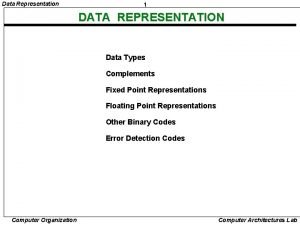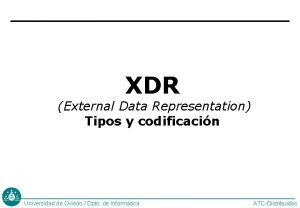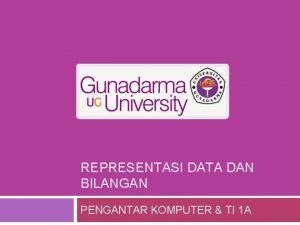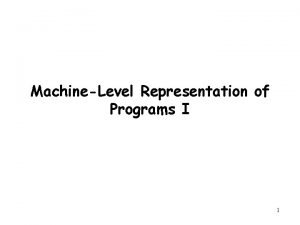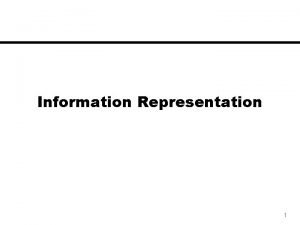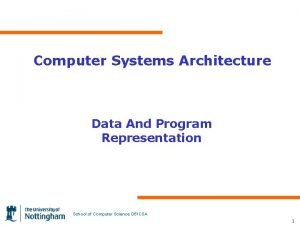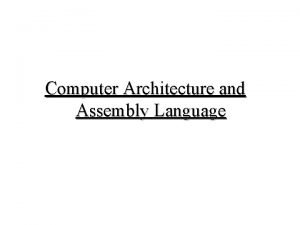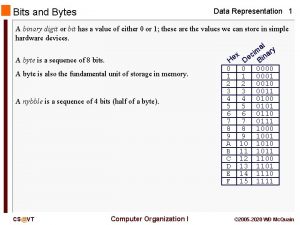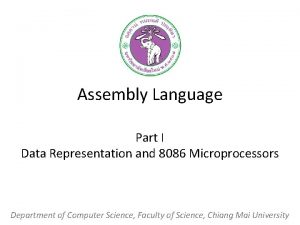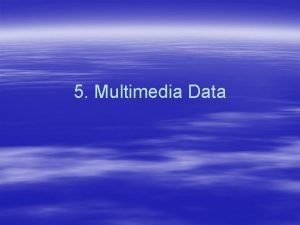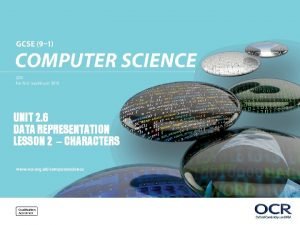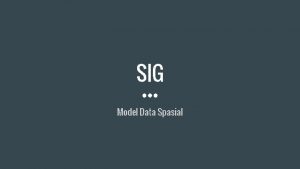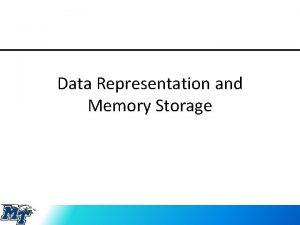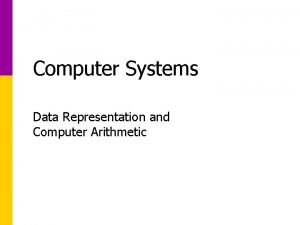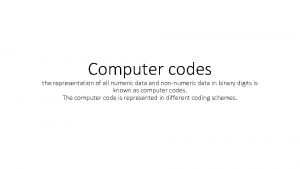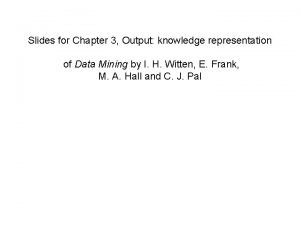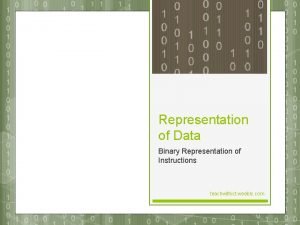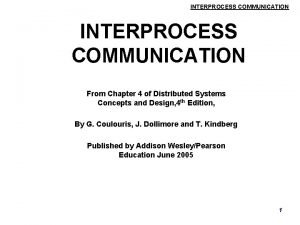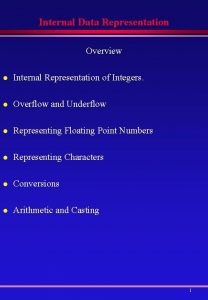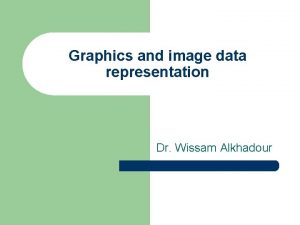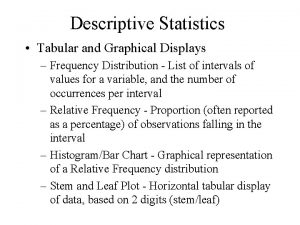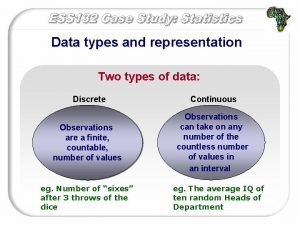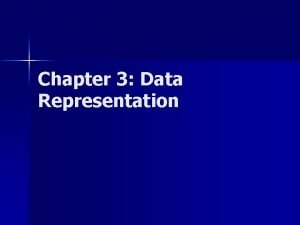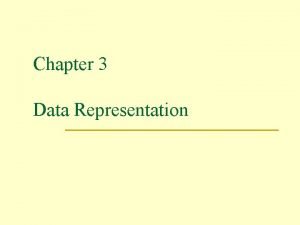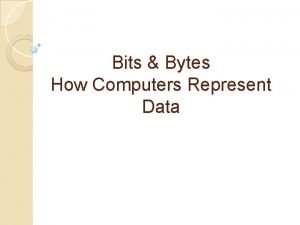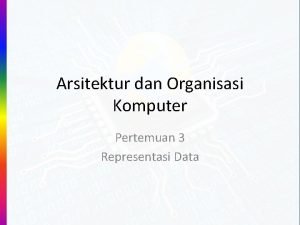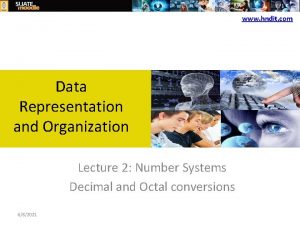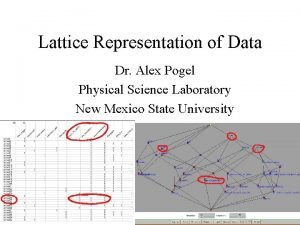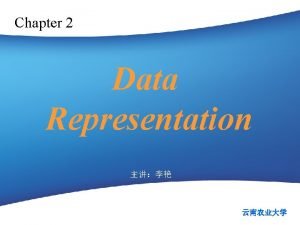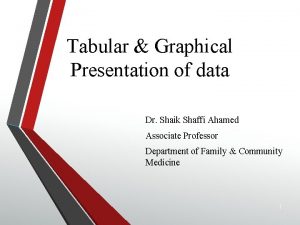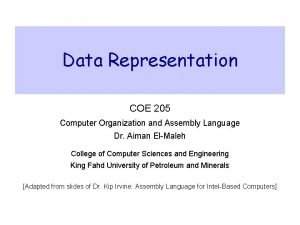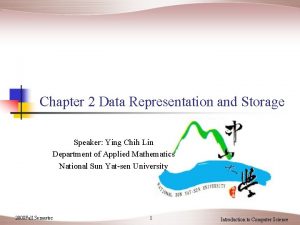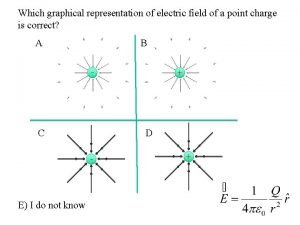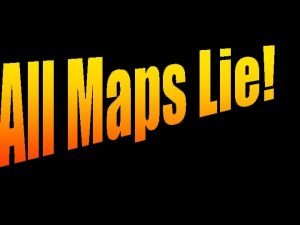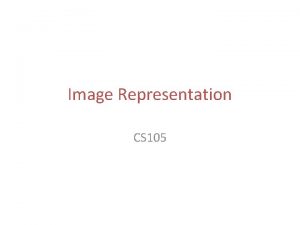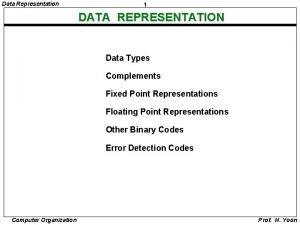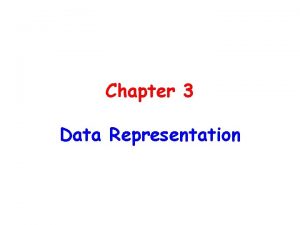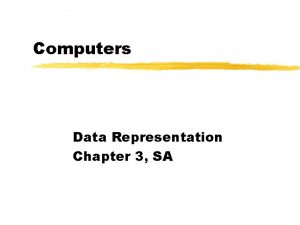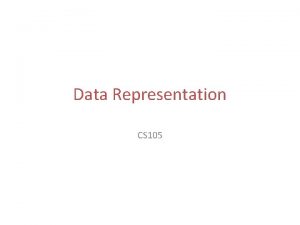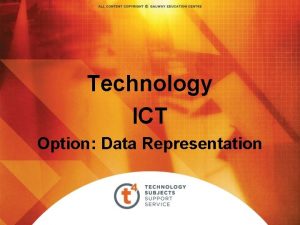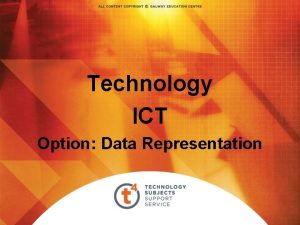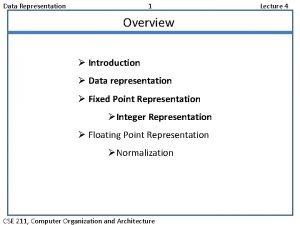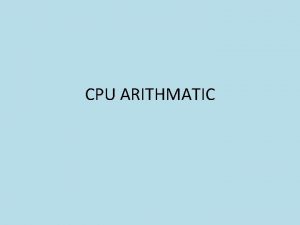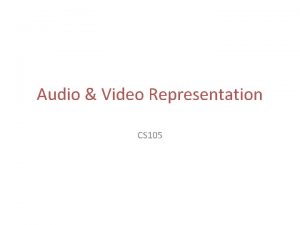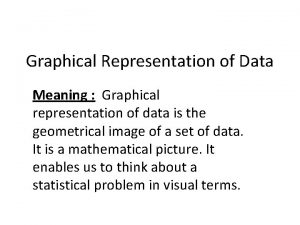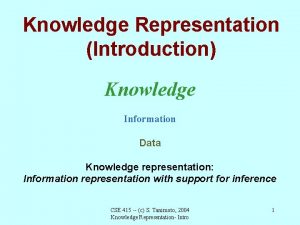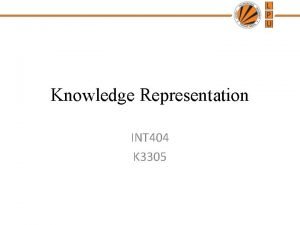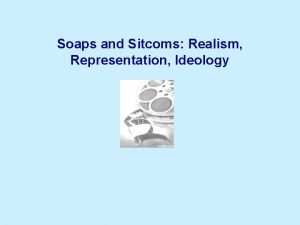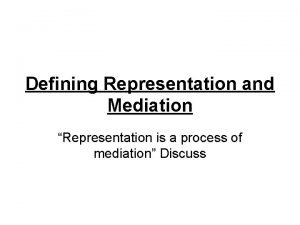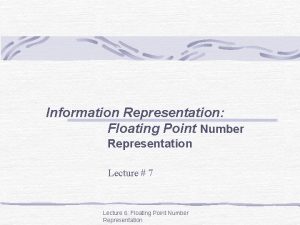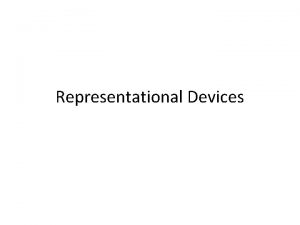Ch 2 Data Representation What is data Data


































- Slides: 34

Ch 2: Data Representation

What is data? Data is information that has been translated into a form that is more convenient to process As information take different forms, the most efficient way is to represent all forms of information using a universal format.

Data Types Multimedia Word processing programs Engineering programs Image processing programs Audio play program Video display programs

Information coding and decoding • Human senses deal with a variety of information (signals). • Input devices of computer translates these information into electrical signals, why electrical? . • Electrical signals are then translated into universal format (0 s, 1 s), this is known as coding. • After processing, output devices transform back data into their original form, this is known as decoding


Bit Pattern • A bit is the smallest unit of data that the computer deals with. • a bit can take two values (0 or 1). • A two-state electrical switch (transistor) is used to represent a bit (on state → 1, off state → 0). • To store 16 bits you need 16 switches, to store million bits you need million switches. • In computer memory data are stored as blocks of bits (bit-patterns), the length of bit-patterns is the number of bits in the bit-patterns. • A bit-pattern of 8 bits length is called a byte

Representing Data: 1. Text Representation • Written text is made of alphabetical symbols (letters). For example, in English there are 26 uppercase and 26 lowercase symbols. • Each of those symbols is represented by distinctive bit-pattern (code), ex table A 1, P 337. • Once alphabetical symbols are represented by a bit-pattern, any word that is made of combination of letters can be represented.

Representation of word “BYTE” Ex: 34 Page 13

Number of bits in bit-pattern • The number of possible bit-patterns (symbols) made of N number of bits, M is given by: M = 2 N • Inversely, the number of bits needed to construct M number of symbols is given by: N= Log 2 M ≈ 3. 2 Log 10 M (Note: N must be rounded to next bigger integer) • Ex: for M = 26, what is the min number of bits? N= Log 2 26 = 3. 2 Log 10 26 = 4. 5 = 5 bits

Code systems for text representation • There about 5 code systems used to represent alphabetical symbols: 1. ASCII (American Standard Code for Information Interchange) 2. Extended ASCII 3. EBCDIC (Extended Coded Decimal Interchange Code) 4. Unicode (Universal Code) 5. ISO (International Organization for Standardization)

(1) ASCII • • • In ASCII codes each code is made of 7 bits. Number of possible codes M = 27 = 128 codes. Bit-patterns ranging from 0000000 to 1111111 The first pattern represents (null character) The last pattern represents (delete character) Appendix A

(2) Extended ASCII • Is invented to make the bit-pattern length equal to 8 bits (Byte), by adding a bit to the left of the ASCII code representation. Ex. If ASCII code is 1111111 the extended ASCII code is 01111111. • Extended ASCII is not used because it is not standardized as each manufacturer has different 8 -bits system.

(3) EBCDIC • Uses 8 bit patterns → # of codes = 28=256 • Just used in IBM mainframe (system)

(4) Unicode • To represent more languages’ character beside English, Unicode is invented. • Uses 16 bit pattern → # of codes = 216=65536 enough to represent all world’s languages. • Some codes are allocated for geographical and special symbols. • Java uses Unicode, Microsoft uses the first 256 symbols • Appendix B

(5) ISO • ISO uses 32 bit patterns → # of codes = 232=4, 294, 967, 296 symbols enough to represent all world’s symbols.

Representing Data: 2. Image Representation Image representation methods

1. Bitmap Graphic • Image is divided into matrix of pixels. • A pixel represents a dot which is the smallest unit of the image. • Image resolution depends on the number of pixels in the image. • Higher resolution images require larger memory. • Once image is divided into pixels, each pixel is given a bit-pattern. • The pixel bit-pattern determines the color of the pixel

Pixel Color (Black & white) • For black and white images, only two bitpatterns are needed, one to represent a black pixel and the other to represent a white pixel. • In this case, the length of the pattern could be only one bit, i. e. 1 pattern to represent a black pixel and 0 pattern to represent a white pixel. • The rows of patterns are then stored in the memory.

Bitmap graphic method of a black-and-white image

Pixel Color (gray scale) • To represent a gray-scale image of 4 colors (for example) we need to increase the length of bit-pattern representing the pixel to be 2 bits. • In this case 00→ black pixel 01→ dark gray pixel 10→ light gray pixel 11→ white pixel

Pixel Color (colored pixel) • Any visible color could be constructed from the 3 basic colors Red, Green, Blue (RBG) • The difference between one color another depends on the intensity of the RBG colors in the color • Therefore, to represent a colored image, each pixel in the image must be represented by 3 different bit-patterns. Each of them represent the intensity of the basic colors. • The length of a bit pattern representing each basic color is usually 8 bits

Representation of color pixels

1. Vector Graphic • Image is decomposed into lines and curves. • Each curve and line is represented by a mathematical formula. • The mathematical formula is sorted. • No bit-patterns are stored • For example a line is described by its coordinates, the circle is described by it’s the coordinates of its centre and length of the radius. • The advantage of vector representation is that image can be scaled by multiplying the formula by the scale factor without effecting the image resolution as in bitmap representation

Representing Data: 3. Audio Representation • Audio is sound • Sound signal is analog signal • The representation of audio signal requires converting analog signal into digital signal (A/D)

Audio representation

Representing Data: 4. Video Representation • Video is a series of images (frame) shown sequentially (one after another) • Thus video data representation is basically the representation of images changed with time. • Video files are multimedia files

Binary Notation • Is a way to write binary numbers • In this way we assign a symbol for multiples of successive bits that makes the binary number • We are going to learn two binary notation systems: – Octal notation: a symbol for 3 bits. – Hexadecimal notation: a symbol for 4 bits.

Decimal numbers • A decimal number is made of digits • A digit takes the value between (0 -9) • Each of the digits is multiplied by its weight which is 10 to the power of 0 for the first digit from the right, 1 for the second digit, 2 for the third digit …. etc


Binary numbers • A binary number is made of digits • A digit takes the value of either 0 or 1 • Each of the digit is multiplied by its weight which is 2 to the power of 0 for the first digit from the right, 1 for the second digit, 2 for the third digit …. Etc


Octal Notation 1. Oct means eight in Greek 2. In Octal notation, successive 3 bits are given a symbol (0, 1, 2, 3, 4, 5, 6, 7). 3. In binary to octal transformation, if the number of bits in a bit pattern is not a multiple of three, we fill with 0 s added to the lift of bit-pattern to make the total number of bits multiple of three. 4. Converted octal notation must be distinguished by either: 1. adding o or O in front of the octal number 2. Adding subscript 8 to the base of the octal number

Hexadecimal Notation 1. hexadec means 16 in Greek 2. In hexadecimal notation, successive 4 bits are given a symbol (0, 1, 2, 3, 4, 5, 6, 7, 8, 9, A, B, C, D, E, F). 3. In binary to hexadecimal transformation, if the number of bits in a bit pattern is not a multiple of four, we fill with 0 s added to the lift of bit-pattern to make the total number of bits multiple of four. 4. Converted hexadecimal notation must be distinguished by either: 1. Adding x or X in front of the hexadecimal number 2. Adding subscript 16 to the base of the hexadecimal number

Note 1. Octal or binary notation is just a way to represent binary numbers (i. e. they are not a numbering systems) 2. You have to make sure the converted number is always distinguished.
 Types of data representation in computer
Types of data representation in computer Xdr external data representation
Xdr external data representation Data representation computer science
Data representation computer science Machine level representation of data
Machine level representation of data Computer memory representation
Computer memory representation Ascii definition computer science
Ascii definition computer science Binary language
Binary language Data representation in memory bit
Data representation in memory bit Data types in assembly language 8086
Data types in assembly language 8086 Multimedia data
Multimedia data Unit 2 data representation
Unit 2 data representation Is a graphical representation of data
Is a graphical representation of data Data representation in memory
Data representation in memory Data representation and computer arithmetic
Data representation and computer arithmetic Representation codes
Representation codes Output knowledge
Output knowledge Teachwithict
Teachwithict Request reply protocol in distributed system
Request reply protocol in distributed system Internal data representation
Internal data representation Image data representation
Image data representation Tabular and graphical representation of data
Tabular and graphical representation of data Two types of data
Two types of data Chapter 3 data representation
Chapter 3 data representation Chapter 3 data representation
Chapter 3 data representation How to represent data
How to represent data Data representation in computer organization
Data representation in computer organization Data representation and organization
Data representation and organization Physical representation of data
Physical representation of data Different forms of data representation
Different forms of data representation Representation of linear array in data structure
Representation of linear array in data structure Tabular and graphical representation of data
Tabular and graphical representation of data Hex code ascii
Hex code ascii Binary representation of data
Binary representation of data Electric field representation
Electric field representation What is the most accurate representation of the earth?
What is the most accurate representation of the earth?
